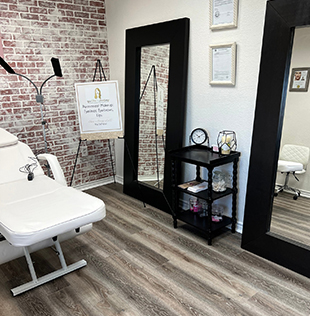— Tattoo and Tiny tattoo
Olen's Beauty studio is a place where you can realize your most cherished dreams and desires regarding a tattoo. Get a quality and safe tattooing service.
If necessary, the Master will help with the selection or production of your unique sketch, advise on the size and place of application.
The cost of a tattoo depends on the size and complexity.
Contact us for more information.
— Tattoo and Tiny tattoo
Olen's Beauty studio is a place where you can realize your most cherished dreams and desires regarding a tattoo. Get a quality and safe tattooing service.
If necessary, the Master will help with the selection or production of your unique sketch, advise on the size and place of application.
The cost of a tattoo depends on the size and complexity.
Contact us for more information.
— Tatoo cosmetics Pre-Procedure and Post-Procedure instraction
Pre-Procedure
All tattoo procedures can be multi-session processes. You can be required to come back for at least one touch-up visit before it can be determined that your work is complete. Touch-up visits are scheduled at 4-6 week intervals or longer.
Be prepared for the color intensity of your procedure to be significantly sharper, brighter, or darker than what is expected for the final outcome. It will take time for this transition and is based upon how quickly the outer layer of your skin exfoliates.
While these tattooed colors may initially simulate the exact color and tone desired, they will not always remain a perfect match. Tattooed colors are constant, while your own skin color will vary depending on exposure to cold, heat, sun and circulatory changes. For example, if you tan your skin and had a scar cam-ouflaged, your surrounding skin will be darker in appearance than the treated area.
- Since delicate skin or sensitive areas may swell slightly or redden, some clients feel it best not to make any social plans for a day or two following any procedure. It is always best to avoid these procedures within months prior to important life events such as weddings. Procedures may take longer than expected to be completed under some circumstances.
- Any tweezing or waxing should be done at least 48 hours prior to the procedure; electrolysis no less than five days before. Do not resume any method of hair removal for at least two weeks.
- Refrain from the use of alcohol, aspirin, aspirin-containing medications, ibuprofen, or other blood-thinning medications for seven days before and two days after any procedure. Refrain from judg-ment-altering drugs for at least 24 hours prior to any procedure. No medication should ever be discontinued without first consulting your physician.
- A skin test is offered upon request.
Attention!
Practitioner makes no attempt to, or claim to, practice medicine. Some Individuals will have complications related to tattoo application. These complications are usually mild and last only a few days. However, extreme complications are always a possibility. If you are healthy and there are no visible reason restriction you from receiving a tattoo, you must approve of the design and color before the application of your tattoo.
Post- Procedure
TATTOO POS-PROCEDURE (AFTER CARE)
The first few days and weeks (for a new tattoo) are probably the most important for your new tattoo. Make sure you care for it properly.Below is the healing procedure and do’s and don’ts we recommend. Because each individual is different, this may not always be the best recommendation for each person.
We recommend you follow the advice of your tattoo artist or seek the advice of a doctor first.
- Leave the bandage that you received after the tattoo on for 2 to 4 hours. Tattoos will ooze, this is a normal part of the heal-ing process. The bandage is there to keep airborne bacteria and any other contaminants in the environment from invading your wound.
- Make sure your hands have been washed thoroughly before you remove the bandage.
- After removing the bandage, cleanse the tattooed area with fragrance free soap and water. Do not scrub the tattoo with a brush or towel (this should not be done until the tattoo has healed). The idea behind the washing is to eliminate any dead cells have been allowed to accumulate on the surface.
- Dry the tattooed area by gently patting the area with a clean, sterile towel.
- Let the tattoo dry completely (approximately 10 minutes)
- After you remove the bandage for the first three days apply a thin layer of antibacterial ointment to the area. After three days when the area start to peels, apply a fragrance free moisturizing lotion to the area 2-3 times daily. Continue applying lotion to the area until the tattoo has stopped peeling.
- You do not need to re-bandage
- Repeat steps above for three-four days, approximately 2-3 times a day. The idea behind this part of the process is to not let the tattoo dry out. After a few days you may notice some peeling and possibly a little scabbing.
Excessive scabbing can indicate a poorly done tattoo, but some scabbing may be normal.
It is at this point in the healing process that our tattoo will begin to itch.
RESIST THE URGE TO SATISFY YOUR DESIRE TO SCRATCH, RUB, OR PICK at the tattoo.
Remember - the first few days and weeks (for a new tattoo) are probably the most important for your new tattoo.
Make sure you care for it properly.
Consult a physician if you experience symptoms such as excessive swelling, redness, yellow or green discharge, fever.
Some final DO’s and DON’Ts DO NOT:
- Go swimming or soak in a hot tub or bath two weeks.
- Use hydrogen peroxide or rubbing alcohol on your tattoo.
- Itch, pick, or scratch the tattoo.
- Participate in activities that will make you sweat DO.
- Stay out of the sun until your tattoo has healed completely.
- Apply sun block to tattoo after it has healed whenever it is exposed to the sun to protect it from damaging ultraviolet rays.
— Tatoo cosmetics Pre-Procedure and Post-Procedure instraction
Pre-Procedure
All tattoo procedures can be multi-session processes. You can be required to come back for at least one touch-up visit before it can be determined that your work is complete. Touch-up visits are scheduled at 4-6 week intervals or longer.
Be prepared for the color intensity of your procedure to be significantly sharper, brighter, or darker than what is expected for the final outcome. It will take time for this transition and is based upon how quickly the outer layer of your skin exfoliates.
While these tattooed colors may initially simulate the exact color and tone desired, they will not always remain a perfect match. Tattooed colors are constant, while your own skin color will vary depending on exposure to cold, heat, sun and circulatory changes. For example, if you tan your skin and had a scar cam-ouflaged, your surrounding skin will be darker in appearance than the treated area.
- Since delicate skin or sensitive areas may swell slightly or redden, some clients feel it best not to make any social plans for a day or two following any procedure. It is always best to avoid these procedures within months prior to important life events such as weddings. Procedures may take longer than expected to be completed under some circumstances.
- Any tweezing or waxing should be done at least 48 hours prior to the procedure; electrolysis no less than five days before. Do not resume any method of hair removal for at least two weeks.
- Refrain from the use of alcohol, aspirin, aspirin-containing medications, ibuprofen, or other blood-thinning medications for seven days before and two days after any procedure. Refrain from judg-ment-altering drugs for at least 24 hours prior to any procedure. No medication should ever be discontinued without first consulting your physician.
- A skin test is offered upon request.
Attention!
Practitioner makes no attempt to, or claim to, practice medicine. Some Individuals will have complications related to tattoo application. These complications are usually mild and last only a few days. However, extreme complications are always a possibility. If you are healthy and there are no visible reason restriction you from receiving a tattoo, you must approve of the design and color before the application of your tattoo.
Post- Procedure
TATTOO POS-PROCEDURE (AFTER CARE)
The first few days and weeks (for a new tattoo) are probably the most important for your new tattoo. Make sure you care for it properly.Below is the healing procedure and do’s and don’ts we recommend. Because each individual is different, this may not always be the best recommendation for each person.
We recommend you follow the advice of your tattoo artist or seek the advice of a doctor first.
- Leave the bandage that you received after the tattoo on for 2 to 4 hours. Tattoos will ooze, this is a normal part of the heal-ing process. The bandage is there to keep airborne bacteria and any other contaminants in the environment from invading your wound.
- Make sure your hands have been washed thoroughly before you remove the bandage.
- After removing the bandage, cleanse the tattooed area with fragrance free soap and water. Do not scrub the tattoo with a brush or towel (this should not be done until the tattoo has healed). The idea behind the washing is to eliminate any dead cells have been allowed to accumulate on the surface.
- Dry the tattooed area by gently patting the area with a clean, sterile towel.
- Let the tattoo dry completely (approximately 10 minutes)
- After you remove the bandage for the first three days apply a thin layer of antibacterial ointment to the area. After three days when the area start to peels, apply a fragrance free moisturizing lotion to the area 2-3 times daily. Continue applying lotion to the area until the tattoo has stopped peeling.
- You do not need to re-bandage
- Repeat steps above for three-four days, approximately 2-3 times a day. The idea behind this part of the process is to not let the tattoo dry out. After a few days you may notice some peeling and possibly a little scabbing.
Excessive scabbing can indicate a poorly done tattoo, but some scabbing may be normal.
It is at this point in the healing process that our tattoo will begin to itch.
RESIST THE URGE TO SATISFY YOUR DESIRE TO SCRATCH, RUB, OR PICK at the tattoo.
Remember - the first few days and weeks (for a new tattoo) are probably the most important for your new tattoo.
Make sure you care for it properly.
Consult a physician if you experience symptoms such as excessive swelling, redness, yellow or green discharge, fever.
Some final DO’s and DON’Ts DO NOT:
- Go swimming or soak in a hot tub or bath two weeks.
- Use hydrogen peroxide or rubbing alcohol on your tattoo.
- Itch, pick, or scratch the tattoo.
- Participate in activities that will make you sweat DO.
- Stay out of the sun until your tattoo has healed completely.
- Apply sun block to tattoo after it has healed whenever it is exposed to the sun to protect it from damaging ultraviolet rays.
— So. Let’s talk...
Address

Olena Mordaunt
8611 Louetta Rd, studio 128
Spring, TX, 77379
@olenamordaunt
@olena.mordaunt
+1-916-547-6161
Appointment
— So. Let’s talk...
Address


